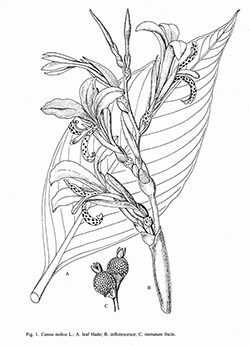e-Flora of Thailand
Volume 9 > Part 2 > Year 2008 > Page 91 > Cannaceae > Canna
1. Canna indica L.wfo-0000343805
Sp. Pl.: 1. 1753; Segeran & Maas, Acta Bot. Neerl. 20: 676. 1971; Ong & Siemonsma in Prosea 9: 63. 1996. Fig. 1.
Accepted Name : This is currently accepted.
Synonyms & Citations :
Description : Rhizome branched. Stem up to 2.5 m high. Leaves with a short petiole; lamina dark green with purple tones, obovate to lanceolate up to 50 by 20 cm. Flowers 1–2 in each cincinnus; bracts green, ovate, 6–9 mm long. Outer tepals lanceolate ca 15 mm; inner tepals joined a base to a 15 mm long, yellow to orange tube, lobes lanceolate, ca 4 cm, yellow or red. Outer staminodes ca 5 by 1 cm; labellum red, often with yellow spots ca 5 cm; stamen lanceolate ca 4.5 cm. Ovary green, ca 5 mm in diam.; style red and yellowish-orange, ca 6 cm. Capsule broadly ovoid 1.5–2 cm long.
Thailand : Cultivated throughout the country and frequently found as a garden escape around villages, often in wet places and along canals.
Distribution : From Bolivia and throughout northern S America northwards to Mexico, cultivated and naturalized throughout the tropics.
Vernacular : Phut tharaksa (พุทธรักษา), sa khu mon (สาคูมอญ)(Central); phut tharaksa kin hua (พุทธรักษากินหัว)(Bangkok); phut thason (พุทธสร)(Northern); sa khu hua kha (สาคูหัวข่า)(Southeastern); bua lawong (บัวละวง)(Lop Buri).
CommonName : Australian arrow-root, Queensland arrow-root, Canna, Edible canna, Indian shot.
Uses: In some parts of the tropics cultivated for its edible rhizomes which are also locally used as medicine. Recently this, the following and other hybrids have been widely used in Thailand in constructed wetlands particularly in peninsular Thailand.

